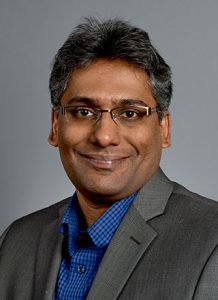July 21, 2020
Edge computing has the potential to make our computers and devices run smarter and faster. Right now, though, the technology is in its infancy and not ready for prime time.

That’s where an inter-institutional research group comes in. Prasad Calyam, an associate professor of electrical engineering and computer science at Mizzou Engineering, is part of a team working to advance edge computing capabilities. The team—led by a University of Massachusetts Amherst researcher—received a $749,998 award from the National Science Foundation.
Edge computing is technology that essentially brings cloud-like capabilities closer to users. Right now, most of our online computing relies on a cloud of servers housed at data centers around the world. Edge computing allows users to store, process and retrieve information closer to where they are located. That allows information to be retrieved and processed faster.
“This project is about understanding how we can deal with data and mobility at the edge where people with demands reside and where most of the data for processing sits,” Calyam said. “It takes a lot of technology to control the cloud, but what we’re trying to do is bring the control closer to the edge. Effective control can decrease backhaul network load to the cloud and improve application performance in terms of responsiveness.”
Improving Drone Capabilities
To do this, researchers will find ways to use edge computing to improve the function of drones. Drones are a good use case because they need detailed, localized information to operate safely and effectively.
“The uses for drone technology grow by the day,” said Michael Zink, a professor of electrical and computer engineering at UMass Amherst and the project’s principal investigator. “One of the biggest challenges these projects face is the need for very detailed, close-to-the-ground weather information for safe operations. And that’s where our research will help.”
Edge computing could make drones better equipped to deliver timely information to decision makers. Calyam also sees potential to improve border security and agriculture. Mounted drones with cameras and sensors, for instance, could monitor areas such as national borders and fields.
“In both cases, generated video and image data needs to be processed,” Calyam said. “In some cases, the processing needs to be done instantly in order to fully leverage the intelligence being gathered by the drones in a timely manner. The major challenge is that the edge devices such as the drones or the ground control station do not have the necessary computation or networking capabilities to manage such data processing Consequently, the edge devices need to be connected in a secure and resilient manner to edge computing or cloud computing resources.”
Providing New Testbeds
The project will allow for workflow processes to be set up on new testbeds. That allows others to use and experiment with the technology. The group will use NSF-supported infrastructures such as GENI, POWDER and FABRIC.
“Today, we run edge computing experiments and cloud computing experiments in an isolated manner due to knowledge limitations in testbed methodologies,” Calyam said. “With the testbeds being planned in this project, we will be able to create advanced testbed methodologies to integrate the edge and cloud sides of workflows. That will allow us to validate or correct many of the assumptions we currently make on what affects application performance.”
Other collaborators on the project include Ewa Deelman from the University of Southern California and Anirban Mandal from the University of North Carolina at Chapel Hill. The team will provide information about the project at www.flynet-ci.org.